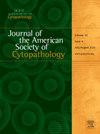高分化神经内分泌肿瘤的嗜瘤细胞亚型:细针穿刺诊断队列的临床病理和分子关联。
Q2 Medicine
Journal of the American Society of Cytopathology
Pub Date : 2025-03-27
DOI:10.1016/j.jasc.2025.03.004
引用次数: 0
摘要
经典的高分化神经内分泌肿瘤(C-NETs)具有浆细胞样形态和神经内分泌分化。肿瘤细胞性NETs (O-NETs)在临床上更具侵袭性。O-NETs是否更类似于C-NETs或低分化神经内分泌癌(PDNECs)尚未确定。材料和方法:比较30例O-NETs(25例胰腺,4例管腔胃肠道)和32例C-NETs(23例胰腺,8例管腔胃肠道)中死亡结构域相关蛋白(DAXX)、α-地中海贫血/智力低下综合征x连锁基因(ATRX)、视网膜母细胞瘤1、p53和SMAD4的临床病理特征和免疫组化表达。在每个队列的一个子集中进行全外显子组测序。结果:O-NETs以男性为主(65.6%),平均Ki-67指数较高(7.4%比2.9%)(P = 0.03),对应较多的2级及以上肿瘤(53.3%)。O-NET患者有更多的晚期疾病(pT3/pT4, 75%对36.8%)(P = 0.024)、远处转移(50%对25%)(P = 0.042)、进展(体积增大/复发/新转移)(n = 8对3;P = 0.1)和死亡(n = 3 vs .1;P = 0.32)。40%的o - net(相对于12.5%的c - net;P = 0.041)显示DAXX/ATRX缺失,其中1例显示视网膜母细胞瘤1和SMAD4缺失共存。所有病例P53染色模式均为野生型。10例患者的全外显子组测序显示,O-NETs和C-NETs中DAXX、ATRX和多发性内分泌肿瘤1型改变,一个O-NET中DNMT3A和MTOR共存改变。结论:与C-NETs相比,O-NET亚型与晚期疾病和不良预后相关。O-NETs是细胞学上独特的,以男性为主的肿瘤,通常表现为更高级别和晚期疾病。他们的攻击行为可能与频繁的DAXX/ATRX丢失和不太可能的pdnec相关分子改变有关。病理学家应该注意这种侵略性的形态亚型,并在病理报告中清楚地传达它的存在。本文章由计算机程序翻译,如有差异,请以英文原文为准。
Oncocytic subtype of well differentiated neuroendocrine tumor: clinicopathologic and molecular associations of a cohort diagnosed on fine needle aspiration (FNA)
Introduction
Classical well differentiated neuroendocrine tumors (C-NETs) have plasmacytoid morphology and neuroendocrine differentiation. Oncocytic NETs (O-NETs) have been shown to be more clinically aggressive. Whether O-NETs are more akin to C-NETs or poorly differentiated neuroendocrine carcinomas (PDNECs) is not established.
Materials and methods
Clinicopathologic characteristics and immunohistochemical expression of death domain-associated protein (DAXX), α-thalassemia/mental retardation syndrome X-linked genes (ATRX), retinoblastoma 1, p53, and SMAD4 in 30 O-NETs (25 pancreatic and 4 from luminal gastrointestinal tract) was compared to 32 C-NETs (23 pancreatic and 8 from luminal gastrointestinal tract). Whole exome sequencing was performed in a subset of each cohort.
Results
O-NETs were male-predominant (65.6%) and had higher mean Ki-67 index (7.4% versus 2.9% in C-NETs) (P = 0.03), corresponding to more grade 2 or above (53.3%) tumors. O-NET patients had more advanced disease (pT3/pT4, 75% versus 36.8%) (P = 0.024), distant metastasis (50% versus 25%) (P = 0.042), progression (increased size/recurrence/new metastases) (n = 8 versus 3; P = 0.1), and death (n = 3 versus 1; P = 0.32). Forty percent of O-NETs (versus 12.5% of C-NETs; P = 0.041) showed DAXX/ATRX loss, with one showing coexisting retinoblastoma 1 and SMAD4 loss. P53 staining pattern was wild type in all cases. Whole exome sequencing of 10 cases showed DAXX, ATRX, and multiple endocrine neoplasia type 1 alterations in O-NETs and C-NETs, and coexisting DNMT3A and MTOR alterations in one O-NET.
Conclusions
O-NET subtype is associated with advanced disease and unfavorable outcomes compared to C-NETs. O-NETs are cytologically distinct, male-predominant tumors that often present with higher grade and advanced disease. Their aggressive behavior is possibly related to frequent DAXX/ATRX loss and less likely PDNEC-related molecular alterations. Pathologists should be mindful of this aggressive morphologic subtype and clearly convey its presence in pathology reports.
求助全文
通过发布文献求助,成功后即可免费获取论文全文。
去求助
来源期刊

Journal of the American Society of Cytopathology
Medicine-Pathology and Forensic Medicine
CiteScore
4.30
自引率
0.00%
发文量
226
审稿时长
40 days
 求助内容:
求助内容: 应助结果提醒方式:
应助结果提醒方式:


